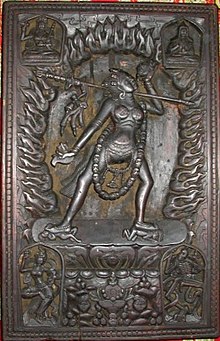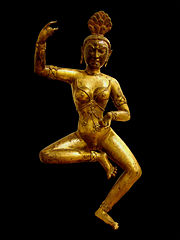Dakini
In Hinduism and Buddhism, a dakini is a female being like a goddess. They are mostly found in Tibetan Buddhism.Chinese: 空行母, Pinyin: Kōngxíng Mǔ and 狐仙,Pinyin:Hú xian ;明妃,Pinyin:Míng fēi} The dakini inspires spiritual practice. A dakini is often depicted as beautiful and naked. The nakedness represents the freedom of the mind.



源平盛衰記人品箋 1840年
The Chinese and Tibetan terms for dakini literally mean "she who travels in the sky"; this is sometimes written poetically as "sky dancer". Their bodies are depicted curved in sinuous dance poses.
Dakinis are associated with energy. They are linked with the revelation of the path of transformation. They help people to change the energy of negative emotions, called poisons (kleshas), into enlightened awareness.
Appearance
changeImages tend to show the dakini as a young, naked figure in a dancing posture, often holding a skull cup filled with menstrual blood or the elixir of life in one hand, and a curved knife in the other. She may wear a garland of human skulls, with a trident staff leaning against her shoulder. Her hair is usually wild and hanging down her back, and her face often wrathful in expression, as she dances on top of a corpse, which represents her complete mastery over ego and ignorance.
Events
changeTibetan Buddhists believe that a Dakini gave a black hat to the third Karmapa, Rangjung Dorje (1284 - 1339), when he was three years old.[1] The Black Crown became the emblem of this Tibetan lineage known as the Karma Kagyu.
Notes
change- ↑ "A portrait of the 3rd Karmapa". Archived from the original on 2008-10-11. Retrieved 2008-01-08.
References
change- Beyer, Stephen (1973). The Cult of Tara: Magic and Ritual in Tibet. University of California Press. ISBN 0-520-02192-4
- English, Elizabeth (2002). Vajrayogini: Her Visualizations, Rituals, and Forms. Wisdom Publications. ISBN 0-86171-329-X
- Norbu, Thinley (1981). Magic Dance: The Display of the Self Nature of the Five Wisdom Dakinis. Jewel Publishing House, 2nd edition. ISBN 0-9607000-0-5
- Padmasambhava, translated by Erik Pema Kunsang (1999) Dakini Teachings. Rangjung Yeshe Publications, 2nd edition. ISBN 962-7341-36-3
- Simmer-Brown, Judith (2001). Dakini's Warm Breath: The Feminine Principle in Tibetan Buddhism. Shambhala Publications. ISBN 1-57062-720-7
- Yeshe, Lama (2001). Introduction to Tantra : The Transformation of Desire. Wisdom Publications, revised edition. ISBN 0-86171-162-9
Other websites
change- Dakini and the Female Spirit Archived 2006-12-19 at the Wayback Machine
- Dakini on khandro.net